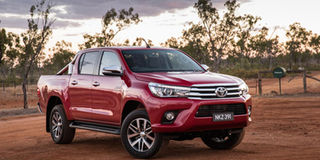A review of the 2016 Toyota Hilux

The 2016 Toyota HILUX is one of the best brand new utility four wheel drive (4WD) vehicles you are about to see in Uganda. This pickup comes from renowned and legendary lineages of utility vehicles whose history spans from the early 20th century in Japan.
It has indelible tyre prints across the world and has been on the Ugandan turf for decades. In this review of the double cab 4WD with a diesel engine.
Design
The Hilux has a bold, imposing business like designs and styling cues. Toyota has passed on to the pickup their new age grille and head light themes shared by their station wagons and smaller sports utility vehicles.
Toyota’s new sharp look underlined by the chrome front grille blends well with the new tear drop LED head lights.
However these don’t sit very well on the chubby front bumper corner edges and side fender wheel arches. This design glitch interrupts the gentle curves of the Hilux door panels.
Nevertheless the side steps and roll bar system remind us that Hilux is responding to a call of duty.
Interior
Behind the wheel, what happens in Vegas doesn’t always stay in Vegas: In the driver’s seat of Hilux you will be treated to the kind of exuberance and razzmatazz synonymous with a modern luxurious saloon vehicle. Generous chrome lining bedecks the stylish dash board air vents, steering spokes and gear selectors.
Meticulous design and clever positioning of accessory knobs and steering controls for the entertainment and information centre, multimedia touch screen console for infotainment with CD, ipod ready, auxiliary ports. The illuminated instrument cluster dials when you turn on the ignition key reminds you that you are sitting in one of the best 4x4 pickups.
Designers and developers of the Toyota have built modern and elegant looking vehicles which offer world class comfort and amenities. The Hilux offers comfortable and ergonomically designed seats. It is bigger on the outside and even bigger on the inside, offers better legroom, headroom as well as shoulder room.
Power and performance
The 2016 Toyota Hilux is powered by a turbo charged diesel engine which is popular because of low end pulling power, better fuel economy and generally more robust service life.
When you start the common rail diesel engine, it is a lot quieter and lacks the diesel clutter of the much older siblings. Toyota Hilux has dropped its engine size from 3.0 litre to the 2.8 litre engine which is quieter and more refined than its predecessor. The Hilux 2.8 litre engine delivers 130 kilowatts of power with a torque of 450NM.
Its front and rear suspension is well designed to provide safer and more comfortable ride on and off road. It is knitted with electric 4 x 4 switchover systems. Toyota Hilux exhibits a faster response from its new traction control system fitted on both front and rear axles. This gives the Hilux a more impressive unladen uphill climb on loose gravel. The downside for Hilux is the rear differential lock which cancels the traction control system when it is engaged.
The Hilux pickup is a go anywhere vehicle designed to handle on and off road terrain.
Steering and suspension
Toyota Hilux has reasonably accurate steering at lower speeds and a bigger cargo space in the pickup bed however its rear axle suspension feels a bit too stiff when loaded with heavy cargo.
Driving dynamics and safety.
It comes with multiple airbag systems with dual front and curtain airbags and pre tensioning seatbelts and child seat anchorage, ABS brake systems with traction control. The Toyota Hilux has also submitted to this test and secured the 5 star node for its 2016 model, for the first time.
Sentra models
2004–2015 Toyota Hilux Vigo
The seventh generation Hilux started production in Thailand during August 2004. Three pickup truck body variants were initially produced: a two-door Single Cab (referred to by Toyota as IMV1), a two-door Xtra Cab (IMV2), and four-door Double Cab (IMV3). In September 2008, Toyota released the Smart Cab, a four-door with hidden rear suicide doors.
1997–2005 Hilux Sport Rider
Toyota introduced a mid-size SUV variant of the Hilux in 1998 for a select few markets, known as the Hilux Sport Rider. The Sport Rider is a rare model, sold in a select few Asian markets, including Thailand and Nepal. Based on the Hilux, both in style and underpinnings, it is similar in concept to the Toyota 4Runner however, the Sport Rider is not a rebadged 4Runner.
1988–1991 Toyota HiLux cab chassis
The Hilux started production in March 1968 as the RN10 in short-wheelbase form with a 1.5 L engine, producing 77 PS (57 kW) in Japanese market spec, and in Japan it was available at Toyota Japan dealership retail chains called Toyota Store and Toyopet Store.




